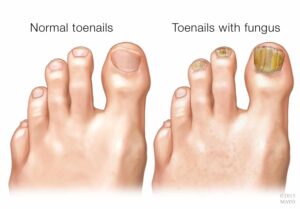Thick fungal nails are extremely hard to trim. Changes caused by toenail fungus can make trimming the nails more difficult than for other people. Typically, toenail fungus is an aesthetic issue that will only cause cosmetic changes. While this is true for most people, there are also functional issues that can arise from this type of infection. It is common for patients to struggle with toenail fungus and feel like their nails are too hard or thick to cut. These functional impairments can deter regular grooming of the nail. The nail overgrowth can make the nails look unhealthy and cause discomfort when wearing shoes.
The difference between healthy nails and fungal nails
Difficult fungal nails cause obstacles to grooming that result from the symptoms of the fungus itself. You can easily trim fully healthy toenails with regular nail clippers without any additional steps.
Normal, healthy nails also differ from fungal nails in other ways. Discoloration from a toenail fungus can hide the skin underneath the nail, which is the opposite of how a normal nail will look. Healthy nails aren’t thick, particularly rough or uneven, or detached from the nail bed.
Nails that have debris buildup of gunk under the nail are also unhealthy. Damages to the nail’s composition are other indications that they are unhealthy and can include cracking or crumbling.
The growth rate of the nails can also be telling. Normal nails should grow at a slow but steady pace. If your nails aren’t growing at all, it indicates that something has damaged them. The nail should be strong and sturdy enough not to break easily, but still easy to cut.

Why do I have Hard Nails?
Hard fungal nails are a frequently seen symptom of toenail fungus. When the nails aren’t infected with a fungus, there should not be any issues trimming through them. Nails that are healthy and normal will have a characteristic look. The nail itself, when healthy, should be clear and expose the pink or brown skin underneath it. A nail in this condition will also be thin, even in texture across its surface, and completely and fully attached to the nail bed.
Debris buildup under the nail, cracking on the surface of the nail, or any other sort of damage that is visible are more signs that the nail isn’t healthy. The nail should grow reasonably fast and have enough structure to stay intact, but still, be soft enough to trim without a problem.
Hard fungal nails are just one of many symptoms of toenail fungus symptoms that can be used to determine if your issue is caused by a fungus or not. The most common visible symptom of nail fungus is a change in the color of the toenail. This discoloration will usually initially show up as a small dot or stripe on the surface of the toenail, which can then grow to cover a larger portion of the nail with time. When fungus goes without effective treatment for an extended period of time, the entire nail can often become covered in discoloration.
Symptoms of Nail Fungus
Difficult fungal nails to trim are one of the many ways fungus can affect the toenail. While hardening and thickening of the nails can be aesthetically negative, what is often more frustrating is the way they affect your nail maintenance routine. These symptoms are especially annoying because they affect your ability to keep up with maintaining a proper routine.
If grooming of your nails has been interfered with by the symptoms of toenail fungus, you still need to regularly groom your nails, but you may need to implement a few additional steps to do it properly.
Difficult fungal nails will still need to be regularly trimmed in accordance with proper hygiene practices. If you let your nails grow excessively long, this will pose health risks that need to be avoided. One health risk that extremely long toenails pose is trapping bacteria and other microorganisms underneath them. When these organisms are under your nails, they can cause other infections. Extremely long nails also pose a risk of ingrown toenails forming. Overgrown toenails break more easily, forming jagged, rough edges that will pierce into the skin of the toe easily.
What to do first?
The first thing to do is to invest in a pair of good nail clippers. If your nails are very thick, the more common clippers will be too flimsy for you. You should look into purchasing a medical-grade nail clipper, which is the kind that is used by podiatrists. When choosing your clippers, carefully consult the reviews to see how other customers liked the clippers, and choose one that will not break or rust easily. You should also make sure that the handles are long enough for you to grip them and that they are not so thin that they slip out of your hand and injure you.
Ways to soften your toenails
Softening difficult fungal nails is definitely a helpful step to trim and groom them. Toenail fungus impacts the difficulty of trimming nails. You will need to take certain steps to counteract these symptoms! When nails become too hard or thick because of a fungus, the blades of traditional home nail clippers may not even fit around them at all. Hardened and thickened nails have more nail material, which makes it more difficult to actually slice through the nails. Softening the nails makes them softer, pliable, and easier to cut, and can be done at home simply by regularly soaking your feet in warm water! All you have to do is fill a tub with water and let the nails soak.
Soaking the feet is helpful in trimming difficult fungal nails, but it will not get rid of the fungus. The most effective treatment is nail fungus laser treatment. The doctor will thin down the nails and then use a laser to kill the fungus. Our laser typically requires one session to completely cure the fungus. To learn more about this treatment or schedule a free consultation with a licensed podiatrist, give us a call at 1-(800) 672-0625 or visit our website for more information.
Tricks for Softening Hard Fungal Nails
Softening hard fungal nails might not be so easy. This blog will discuss tricks to help you. The effects of toenail fungus are not only detrimental to the aesthetic appearance of the toenail but can have negative functional effects as well. Toenail fungus can make the nail become thickened and especially hard. When toenails are in this condition, trimming them can be hard. It can be hard to even fit your nail inside the toenail clippers because they are thick. If they are hardened, the clippers may not be strong enough to get through them. Luckily, there are some softening tricks you can try to improve your toenails before you eliminate the fungus medically.
Foot soak instructions
The first trick to softening hard fungal nails is to soak them. Foot soaks can be done in any basin of water, like a bathtub or bucket. If you need to do foot soaks regularly, you can even purchase machines specifically designed for the purpose. Soak your feet in warm water for about 30 minutes every day.
Immediately after soaking them, try trimming them again. Hopefully, softening your nails in the warm water soak will be enough to allow for normal grooming. You can soak them for consecutive days for better results. If you need to do this for your fungal nails, a good investment is an at-home foot bath machine. This will increase your comfort and make softening your nails feel relaxing.
If soaking your feet doesn’t soften the nails enough, there are creams available as well. Nail softening creams can be applied nightly. They will soften the nail and make it easier to cut.
How do you prep your nails for clipping?
Next, you should prep your nails for trimming. Since your nails are so thick, you may find it necessary and helpful to soak your feet to soften the nails before cutting them. You may take this opportunity to soak them in a dilution of apple cider vinegar or some Epsom salts. This is because there is some anecdotal evidence that apple cider vinegar can fight nail fungus, while Epsom salts can feel relaxing for your feet. To make the experience more enjoyable, you can use a foot bath.
How to correctly cut nails
While actually cutting your nails, you should cut them straight across to prevent ingrown toenails from developing from jagged or pointed corners, which is very painful. You should keep them short for hygiene, but avoid cutting them too short since cuts and exposed skin on the nail bed increase the risk for further infections.
Once you are finished clipping your nails, dispose of the nail clippings in a safe way so that others are not exposed to the fungus and risk infection. A very important step that patients often forget is to clean the clippers after use. Use alcohol or diluted bleach as disinfectants to clean off the clippers after every use. If you do not do this, you will be reinfecting yourself every time you use the clippers.
Life with thick nails
Thick fungal nails will need to be trimmed as frequently as possible in accordance with good hygiene practices. This is necessary to avoid the health risks that long, overgrown nails can cause. Extremely long toenails easily trap bacteria under their tips that can cause other infections. Overly long toenails will also increase the risk of developing ingrown toenails. Long toenails will break very easily since they can get caught on surfaces. These broken toenails will usually have jagged, rough edges that will pierce into the skin easily. Walking around in shoes with long toenails will likely be uncomfortable since they may press up against your socks and shoes. Excessively long toenails will likely cause harm to your toe and nail health down the line.
Reason to soften nails
Softening thick fungal nails is sometimes an essential step to be able to trim them. This is because the symptoms of toenail fungus can directly impact the difficulty of trimming the nails. As nails become thick, traditional nail clippers might be too small to fit around them. Thickened nails are also physically more difficult to cut than those of a normal thickness. The thickness adds more nail material for the nail clippers to slice through, which presents more resistance to the blades. Thickened nails may also be hardened by the fungal infection. This means that even if the toenail is the same thickness as it normally is, the nail material itself can still be more difficult to cut. Softening the nails to trim them provides a solution by making the nail softer and more pliable.
Softening thick fungal nails is essential to their regular maintenance. This helps bypass functional difficulties caused by the fungal infection. Fixing the fungal infection itself is the only permanent way to treat toenail fungus infection and the resulting thickness.
Ways to soften nails
Maintaining the nails can be done by softening them with water in the meantime. By using a foot soak to soften the nail. You can accessibly and effectively groom hard and thick fungal nails. This is an easy technique that can be DIY’d at home with little additional materials necessary. All you have to do is fill a container with enough warm water to completely cover your feet, and soak your nails for 20-40 minutes. After soaking, try to trim them again. If the nails are still not able to be trimmed, you can try soaking your toes again daily until they’re soft enough to cut. If your nail is particularly thick, you can even try buffing off some of the nail’s thickness with a nail file or nail buffing tool as well.
While soaking the feet is helpful at trimming hard fungal nails, the best thing to do in this situation is to be seen by a licensed podiatrist. They will be able to provide effective care for the fungus, and hopefully treat the fungal infection itself once and for all. The gold star for fungus removal is the PinPointe laser, which typically only requires one session to completely eliminate the fungus. To learn more about this treatment or schedule a free consultation with a licensed podiatrist, give us a call at 1-(800) 672-0625 or visit our website for more information.
Temporary Fix
Temporary fixes like softening for trimming fungal nails will only go so far. Eventually, you will need to receive treatment for the root cause of the issue itself. This is often easier said than done; many patients have been trying to treat their toenail fungus for years with minimal positive results. This is because the efficacy of most fungal treatments tends to be very low. Topical treatments for toenail fungus, whether prescription or not, often require a year or more of application before any results are seen at all.
Even after results start to show, you will need to wait further before the condition is healed. Oral medications for fungus treatment are a little more effective than topicals, but these medications are also relatively weak. The bigger downside with oral medications for fungus is that they are very dangerous and can cause severe side effects like liver toxicity. For this reason, bloodwork is necessary before and after a course of oral antifungal medication.
Laser Treatment for Fungal Nails
The best option to permanently cure toenail fungus and make trimming fungal nails much easier is the PinPointe laser. This treatment only requires one session to completely eliminate the fungus and has been FDA-approved for over 10 years. To view the doctors that we work with over 150 podiatry clinics nationwide, visit our locations website here. You can schedule a consultation with one of our podiatrists by calling 800-672-0625 or by submitting an inquiry on our website.




